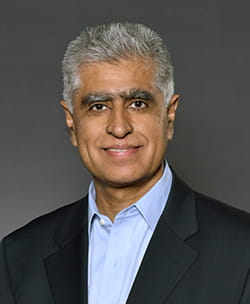
Thought Leadership
The Dual Mindset of Supply Chain Risk
There are two kinds of general supply-chain risk, according to Professor Sunil Chopra — recurrent and disruptive. And a properly designed supply chain will address both.
Chopra is the academic director of Kellogg Executive Education’s Supply Chain Management program, which focuses on how supply chains can be built to deal with risk in general. In the program, he stresses preparation for recurrent risks, which could include such issues as demand fluctuation, late supply deliveries or quality problems. On the flip side are disruptive risks, such as weather, contamination or similar troubles. “The classic example would be the earthquake and subsequent tsunami in Fukushima, which knocked out a variety of plants in Japan so that they could not send supply,” Chopra explained.
It’s best to keep the two kinds of possible disruptions in mind when mapping out a supply chain. “For example, a common approach to deal with demand risk is to try to think of ways of aggregating demand, inventories or production,” Chopra said. “If I’m trying to serve multiple markets, I can locate in each one. But now I have to carry inventory or product for each one of those markets, and each market is subject to demand risks. I don’t know what demand in any market will be. One market can have too much demand and too little inventory, while another can have the opposite.”
The answer to that problem might be to centralize, satisfying demand from a single location. However, that leaves your chain vulnerable to disruptive risk because a problem in one location shuts the entire operation down. So the solution is a hybrid approach. In the demand-risk example, one way to address the challenge might be to set up local facilities to deal with the predictable side and a centralized facility to deal with the risk side. If, for example, the demand fluctuates from 500 to a thousand units, the predictable element is that we know we’ll sell at least 500. The local facilities can be set up to handle that 500. If the centralized location handles the other potential 500, it makes for a much more flexible system. “So what I’ve done is dealt very well with recurrent risk but have also allowed myself to deal with disruptive risk,” Chopra said. “Even if the local facility is disrupted, I can supply it from the centralized part.”
A real-world example of such a set-up was a Philips semiconductor plant in Albuquerque, N.M., that served both Nokia and Ericsson. Nokia had other plants available to supply it, while Ericsson kept costs down by single-sourcing. When the plant caught fire and was shut down, Ericsson found itself unable to obtain semiconductors for a month at a time when it was introducing a new phone. Nokia, meanwhile, moved to another plant and lost only three days of production. “Ericsson reported a $400-million shortfall because of that,” Chopra noted. “The hybrid network Nokia set up allowed it to deal with the disruption.”
The key to incorporating such an approach is to maintain two mentalities at once, Chopra advised. “Basically, it’s very hard to wrap your head around the following: ‘I’m going to make shirts of the same fabric the same way, but in one facility, it’ll be made for 20 dollars, and it’ll be 30 dollars in the other. Why shouldn’t I make them only in the 20-dollar one? Also, those two facilities must be managed in two different ways. The predictable one doesn’t have to worry as much about planning, while the other has to be very flexible because we don’t know what size the order will be or where it’ll come from.”
Two real-world examples of that phenomenon demonstrate the difficulties of maintaining such a balancing act within one company. Walmart took more than a decade before it really made its web operations work, Chopra said. Meanwhile, Amazon has the opposite problem after absorbing Whole Foods. “Amazon started with everything centralized, and Walmart started in thousands of locations. It becomes very hard to absorb the opposite way of thinking.”
Very hard indeed. But it can make all the difference the next time the earth shakes or something catches fire.
 |
Sunil Chopra is the IBM Distinguished Professor of Operations Management at Kellogg School of Management. He was also Interim Dean of Kellogg from 2009-2010. From 2006-2009, he served as Senior Associate Dean: Curriculum and Teaching. He became a faculty member of the school in 1989. Previously he was an Assistant Professor at the Stern School of Business Administration at New York University. He has a PhD in Operations Research from SUNY Stony Brook. |
Download a Brochure >
Spaces are limited. Register today.
Related Programs
Operations Management BundleOperations Strategy
Lean Operations
Portfolio
Operations & Technology
Supply Chain Management
Revolutionize your operations with the latest tools, techniques and models for efficient — and effective — supply chain management. The experts will show you how to meet the complex challenges of managing facilities, inventories, transportation, information, outsourcing, strategic partnering and more.
Upcoming Sessions
|
April 29 - May 2, 2025 Start: April 29 at 10:15 AM End: May 2 at 2:30 PM
LOCATION:
|
$5,850 Special Live Virtual Discount: When registering, use code VIRTUAL20 in the "Affiliation ID" box to save 20% on the upcoming live virtual session. |
|
|
October 20-24, 2025 Start: October 20 at 8:30 AM End: October 24 at 1:45 PM
LOCATION:
|
$5,850 |



